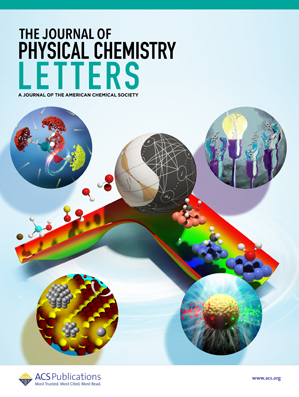Segregation of Chemical Groups at PMMA/H2O Interface Leads to Different Local Hydrophobicity.
IF 4.8
2区 化学
Q2 CHEMISTRY, PHYSICAL
引用次数: 0
Abstract
The local hydrophilicity of polymer surfaces is essential for many applications, such as coatings and biocompatibility, but revealing its structural origin is challenging. Here, we used poly(methyl methacrylate) (PMMA) film as a model and excavated several SFG spectral features, generated by femtosecond sum-frequency generation vibrational spectroscopy (SFG-VS), to elucidate the nature of microscopic hydrophilicity of a polymer/H2O interface. For the first time, we successfully probed the SFG spectra of the bend-libration combination band of interfacial water, which exhibits high sensitivity to solvent-water interactions. Two local hydrophilic domains are observed at the PMMA/H2O interface. The segregation of -OCH3 and -CH3 groups to the PMMA/H2O interface results in the formation of a local hydrophobic domain, where weak solvent-water interactions, slow vibrational dynamics of OH stretching, and no ice-like interfacial water are detected. In contrast, when both C═O and -OCH3 groups segregate to the PMMA/water interface, a local hydrophilic domain is formed, leading to strong solvent-water interactions, fast vibrational dynamics of OH stretching, and the presence of ice-like interfacial water. The water molecules around the hydrophobic domains of the PMMA surface are mainly liquid-like water rather than ice-like water. This work contributes to a molecular-level understanding of the local hydrophilicity of polymer surfaces.PMMA/H2O界面化学基团的分离导致了不同的局部疏水性。
聚合物表面的局部亲水性对于许多应用至关重要,例如涂层和生物相容性,但揭示其结构起源是具有挑战性的。本研究以聚甲基丙烯酸甲酯(PMMA)薄膜为模型,利用飞秒和频产生振动光谱(SFG- vs)分析了聚合物/水界面微观亲水性的特征。我们首次成功探测了界面水的弯曲-振动组合带的SFG光谱,该光谱对溶剂-水相互作用具有很高的敏感性。在PMMA/H2O界面上观察到两个局部亲水结构域。-OCH3和-CH3基团在PMMA/H2O界面上的分离导致了局部疏水区域的形成,其中溶剂-水相互作用弱,OH拉伸的振动动力学慢,没有检测到冰状界面水。相反,当C = O和-OCH3基团都分离到PMMA/水界面时,形成一个局部亲水结构域,导致强的溶剂-水相互作用,OH拉伸的快速振动动力学,以及冰状界面水的存在。聚甲基丙烯酸甲酯表面疏水区域周围的水分子主要是液态水而不是冰状水。这项工作有助于在分子水平上理解聚合物表面的局部亲水性。
本文章由计算机程序翻译,如有差异,请以英文原文为准。
求助全文
约1分钟内获得全文
求助全文
来源期刊

The Journal of Physical Chemistry Letters
CHEMISTRY, PHYSICAL-NANOSCIENCE & NANOTECHNOLOGY
CiteScore
9.60
自引率
7.00%
发文量
1519
审稿时长
1.6 months
期刊介绍:
The Journal of Physical Chemistry (JPC) Letters is devoted to reporting new and original experimental and theoretical basic research of interest to physical chemists, biophysical chemists, chemical physicists, physicists, material scientists, and engineers. An important criterion for acceptance is that the paper reports a significant scientific advance and/or physical insight such that rapid publication is essential. Two issues of JPC Letters are published each month.
 求助内容:
求助内容: 应助结果提醒方式:
应助结果提醒方式:


